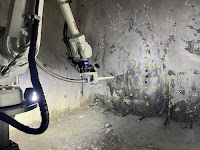Every company’s electrical safety strategy should be based around limiting workers’ exposure to such electrical hazards as arc flash and electrocution. Fluke says the best way to keep operators out of harm’s way is to give them access to the right non-contact tools that not only protect them but also reduce dramatically (by up to half) the amount of time they are required to work on live circuits in arc flash zones.
Arc flash is the light and heat created from an arc fault explosion and temperatures can reach up to 19,000°C (35,000°F), capable of igniting an operator’s clothing and burning the skin of anyone within a few feet. Arc flash can also melt metal, cause lung and eyesight damage and lead to hospitalisation, even death.
Engineers and health & safety teams will be familiar with the need to establish arc flash boundaries and wear arc-rated clothing and rubber insulating gloves. However, using non-contact test and measurement tools means operators are able to minimise the level of personal protective equipment (PPE) required as well as the amount of time they need to spend inside the boundary.
One such product is Fluke’s PQ400 electrical measurement window (EMW), which is permanently installed into cabinets with voltage and current connections made inside the panel. The PQ400 gives workers access to critical power quality and energy data while decreasing testing time and maintaining a high level of safety. Users can plug their power quality tools directly into the EMW to collect all the data that’s needed.
As well as the safety aspects, advantages of using the PQ400 include lower maintenance costs and reduced downtime by being able to make critical power quality and energy measurements without opening the panel door. The EMW also enables logging and monitoring to be done at any time, without disrupting operations, while measurement efficiency is increased.
A second product – Fluke’s CV400 ClirVu 4in window – is a permanent infra-red window that provides a view of what’s on the other side of a panel without workers being exposed to live voltage or needing full PPE. Offering the most visibility into a panel for a thermal camera (simplifying the inspection process by allowing measurements to be taken without having to open a cabinet), the widest Fluke window option available also helps to reduce time and costs involved in preventive maintenance.
 |
| TiS75+ |
 |
| 376FC |
Finally, the Fluke 3000FC digital multimeter is a flexible DMM allowing users to read results through the Fluke Connect app, outside the arc flash boundary. Using this equipment cuts the time technicians spend inside the boundary and offers them an easy-to-read display with large digits and bright backlight.
Says Eric van Riet: “There’s no need for engineers to put themselves in an arc blast zone if they can avoid being there. Products such as wireless and non-contact tools as well as remote displays can help place them as far away as possible from risk and danger while allowing them to take accurate, instant readings that can be analysed remotely. Arc flash safety is essential, and the latest thermal imaging and wireless testing tools are the best way to offer operators maximum protection.”









































